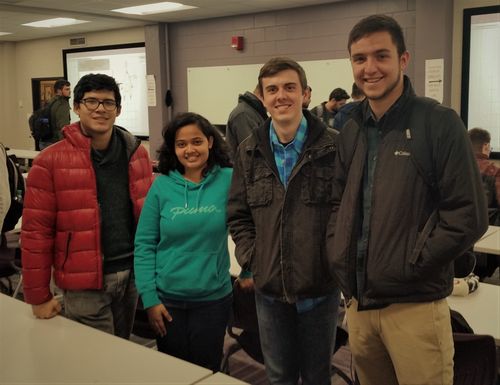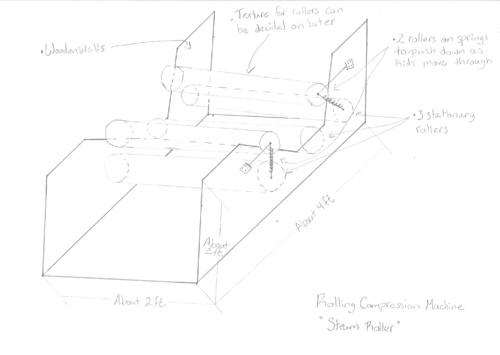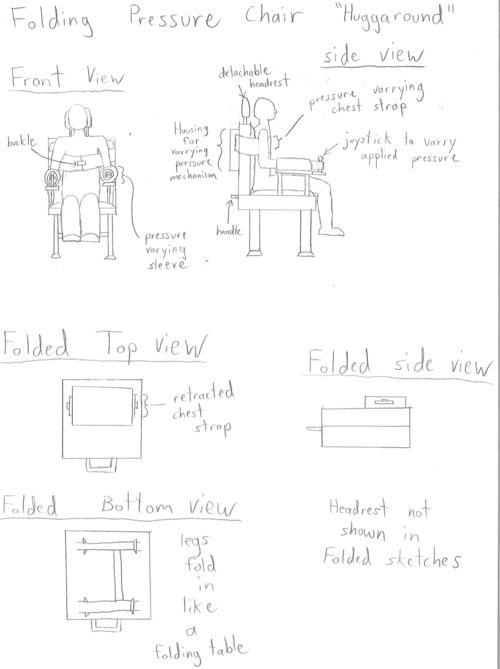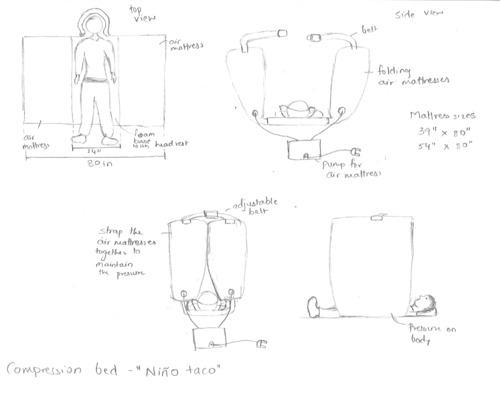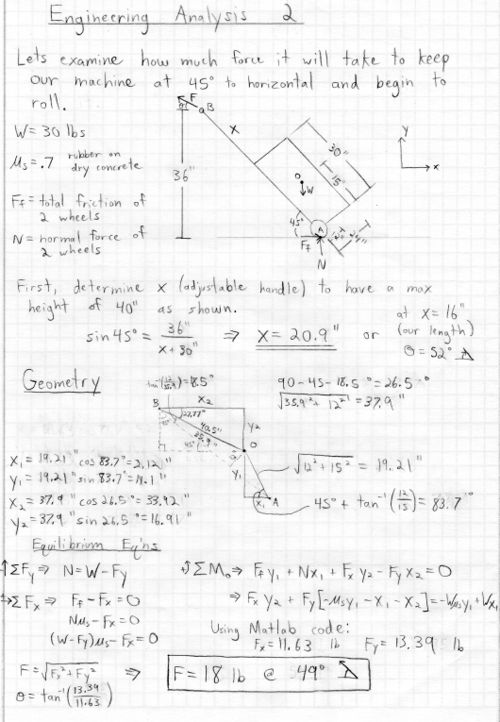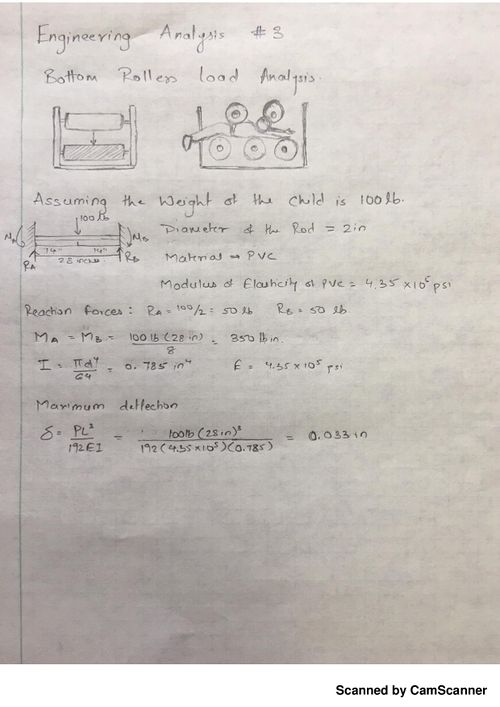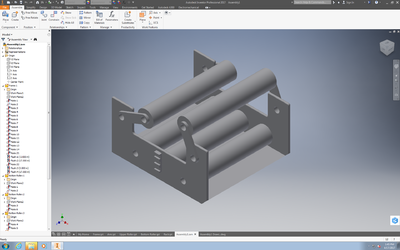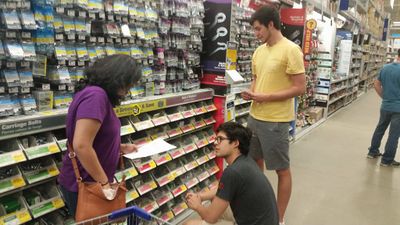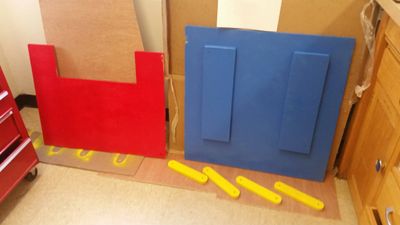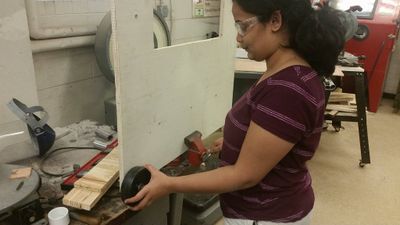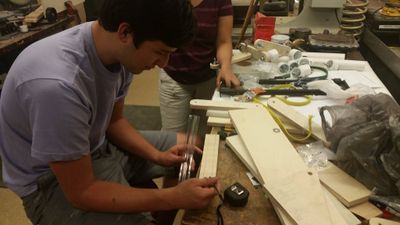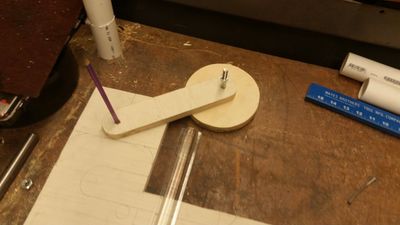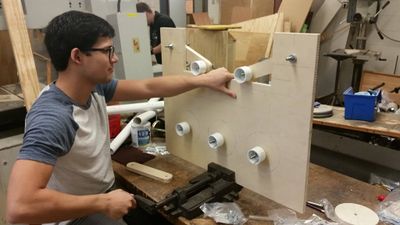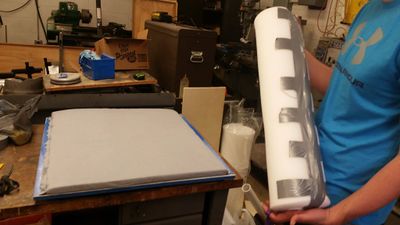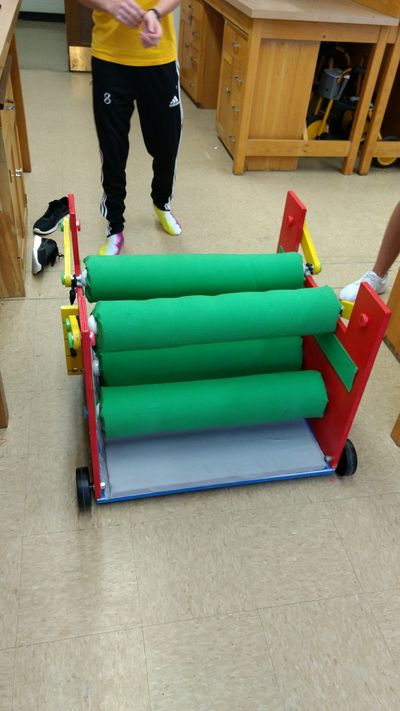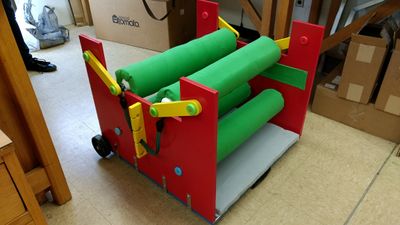Squeeze Machine
Abstract
For this project, we will construct a "squeeze machine" as a therapy device for children with ASD. Our machine will be durable and portable for use for therapy or play.
Team members
From left to right:
- Sebastian Barajas
- Sanika Sovani
- Benjamin Suggs
- Michael Baker
With help from:
- Karyn Henderson
- Dr. Canfield
- Jared Smith and his truck
(not pictured)
Problem Statement/overview of the need
Children who grow up with a spectrum of autism tend to find a sense of comfort in the feeling of compression around their bodies. Our machine will need to be able to give the children the compression that they like while being portable, pleasant to touch and see, and sturdy. The machine will need be used in play and therapy, so it will also need to be simple to clean and store.
Design Specifications
- The machine should be portable (lightweight)
- The machine is intended for elementary school children (ages 3-11). Therefore, the machine should be small in size.
- The texture of the material used to build this machine should be smooth as rough texture might make the child uncomfortable.
- Size of machine: roughly 3ft X 2.5ft X 2ft or smaller
Background research
There are already a variety of squeeze machines out on the market. They are not very easily obtained, due to their limited suppliers and extravagant costs. There are large wooden models that squeeze children for sensory input, and also a few compressions vests. The major downside to these are the steep costs that are unrealistic for a family. An important lack in what products are out currently is there are almost no portable devices. Most of the devices on the market currently are stationary and are not easily moved; We will be addressing both the cost and portability problems.
- Bulleted list item
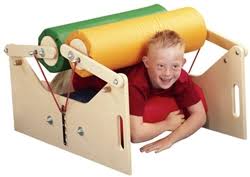 This product is $529 online.
This product is $529 online.
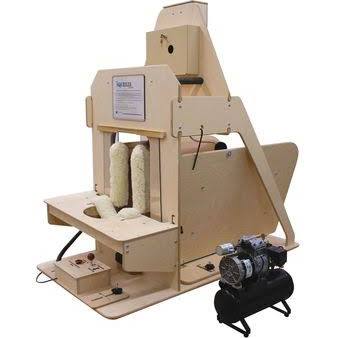 This product is $9,233 online.
This product is $9,233 online.
Conceptual Design
For our conceptual design process, we started with looking at squeeze machines that were already in the market. Some we had seen before, others we had not. The ones we found really helped us with our next step, brainstorming. We sat down and drew some very rough sketches of what popped into our minds; some were good, others not so much. We tried to incorporate our own ideas into what was already out there to make our squeeze machines portable, effective, and good quality. Here are some of the concepts we came up with:
Rolling Compression Machine
- This device will both combine play and therapy. A child can enter from either side and the rollers will add a compression force to there whole body. We plan on making the sides out of wood and having the rollers made of some sort of cushion. Everything will need to have a soothing texture to allow children who are tactile defensive to use this device.
- We think using wood will make the rolling compression machine light yet sturdy enough to support the weight of a 3-11 year old child (max 100 lbs). Maybe have it easily separable to allow for better portability. Also, the springs could be adjusted to allow for more or less compression to the child.
Folding Pressure Chair
- The Folding Pressure Chair is more meant for therapy than fun. It allows the child to be in complete control of the pressure they are feeling around their arms and chest. This device would be very portable because it would be able to fold, and it comes with a detachable headrest. The chair could be powered by a wall plug or a battery pack depending on the need.
- For the adjustable pressure, we would use a gear mechanism in the back of the chair to adjust the chest and arm straps. We thought we could make it using some kind of metal to make it easier to fold, similar to a folding table. One concern we had was that the child may feel too constrained or uncomfortable in the chair.
Compression Bed
- The Compression Bed is simply an air mattress that wraps around the child. This allows for a full body compressing feeling for the child. And once deflated, the bed would be portable. It would be capable of fitting any size of child comfortably.
- The bed's pressure would be adjustable by the amount of air pumped into it and the adjustable straps on the top of the device. We would have a foam base and headrest to allow for more support when laying on the ground. Our number one concern for this device is the sound of the air pump would put the child in distress.
SELECTED CANDIDATE-- ROLLING COMPRESSION MACHINE
| Device | Adjustable Compression | Portability | Therapy/Play | Difficulty to Build (1-10) |
|---|---|---|---|---|
| Rolling Compression Machine | yes | possible | both | 5 |
| Folding Pressure Chair | yes | yes | therapy | 8 |
| Compression Bed | yes | yes | therapy | 3 |
We have chosen the Rolling Compression Machine because of its ability to be both a therapy and play machine. We believe we can make it portable yet capable of withstanding the loads it will go through. Also, when compared to the Folding Pressure Chair, we think the Rolling Compression Machine would be easier to build.
Detailed Design
Description of selected design
The design we selected best fits our clients needs. We modified design concept one in order to better fit the needs and parameters given. It is a design that is built to give a child moving through it sensory input, using pressure from a system of adjustable rollers. It will have many adjustable parts to it in order to custom tailor to each child's likes/dislikes. The wooden frame will also have curved edges as a requested safety measure from our client.
Detailed description of selected design
The frame of the machine will be constructed out of wood and will have 24in height, 30in length, and 30in width. The frame will have an attached handle and wheels slotted into the corner of the frame to make the design more portable. There are rollers on the top, bottom, and sides of the frame. The bottom rollers (6in diameter) will be stationary and non-adjustable. While, the top rollers (6in diameter) are attached to swing arms with bungee cord resistance to provide different amounts of pressure tailored to the child using it. The rollers will consist of a PVC pipe surrounded by padding and a smooth fabric.
Analysis
Describe three types of analysis to be performed on the design
Engineering analysis 1
Upon first consideration of vertical rollers within the mechanism,
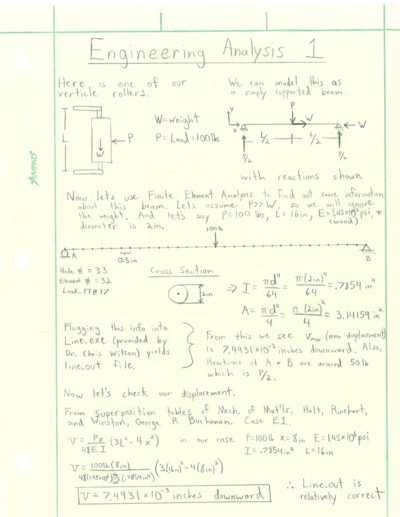
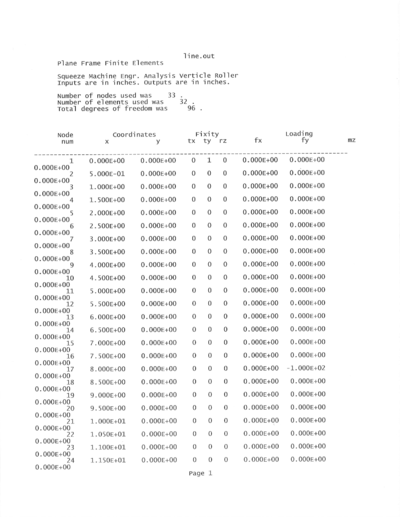
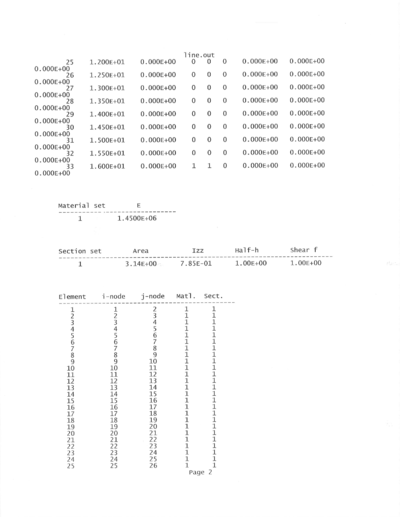
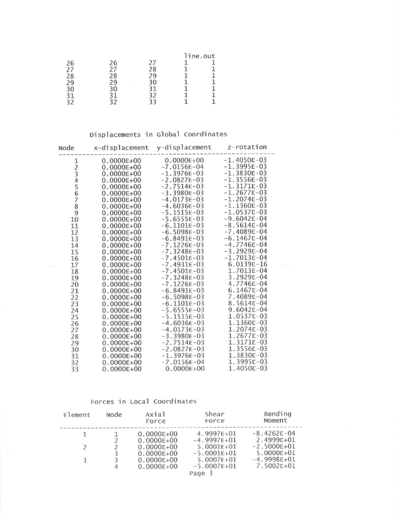

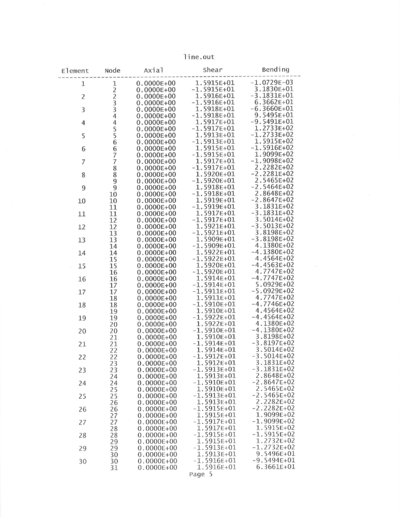

Engineering analysis 2
clear all clc
x1=2.12; y1=19.1; x2=33.92; y2=16.91; %inch us=.7; %rubber on dry concrete W=25; %lbs
A=[1 us; y2 -us*y1-x1-x2]; b=[W*us; -W*us*y1-W*x1]; F=inv(A)*b F =
11.63 13.39
Engineering analysis 3
CAD Drawings
Bill of Materials
Assembly Instructions
We will begin by creating all the necessary parts required to build the squeeze machine. We will first attach the padding to the base board along with the handle and wheels and the pvc covers to the side panels. Then, we will link the side panels to each other using the pvc pipes. Once done, we will attach the joined panels to the completed base. Afterwords, we shall attach the two arms and add the pvc pipe & covers. Finally, we shall attach the brackets onto the outside of the side panels and latch the bungee cord to the arms.
Fabrication Process
Testing and implementation
For testing, we had 2 160lb subjects go though the Squeeze Machine. Both times the cushions held and the walls stayed up.
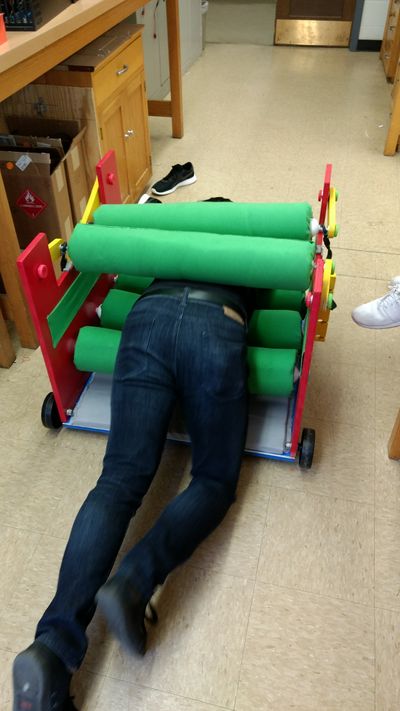
As for the delivery, we all drove to the therapist's location and presented the Squeeze Machine to her and she tested the effectiveness on one of her kids, who after a few rounds, showed a liking to the toy and more at ease. The Squeeze Machine is a simple device to use, with 2 ends for the kids to go through and notches to adjust the tension for the top two rollers, this toy is fit to give soothing compression to kids ages 3 to 11.
Photos of Completed design
Instructions for safe use
The squeeze machine is a device used to provide sensory input. The squeeze machine should not be used without supervision of a therapist. The child should enter the machine and crawl/squeeze through the top and bottom rollers for proper use. The child should not sit on or climb on top of the top rollers as this may cause injury.
Project Summary, Reflection
In the end, this project was successful and rewarding to us and the therapists. It was a unique opportunity to help a group of kids with special needs when the market typically charges toys and tools like the Squeeze Machine more than many parents can afford. The chance to make a more affordable and better product was a goal of ours and time will tell how well we built the Squeeze Machine.
